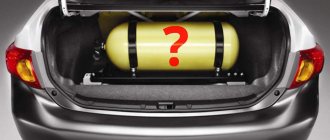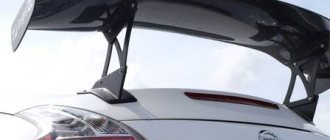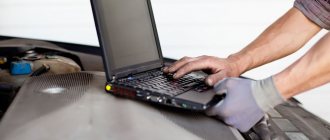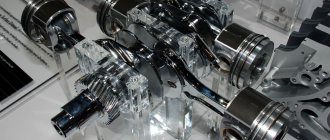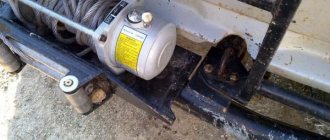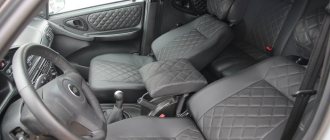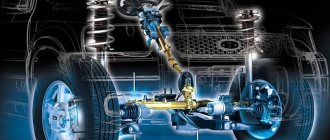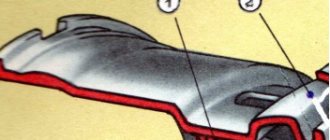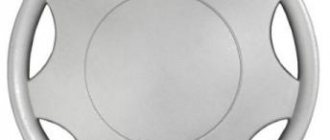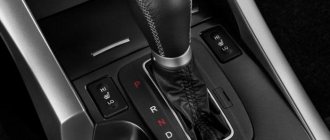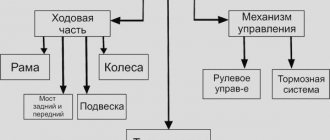If several decades ago a winch was installed mainly on special equipment operating in harsh off-road conditions, now such a device has ceased to be exotic for ordinary vehicles. Depending on the type of mechanism, most motorists will not have much difficulty finding a winch at an automotive accessories store.
These products are very popular among those who like to conquer rough off-road terrain. Especially often, such mechanisms can be seen on the bumper of a full-fledged SUV with high ground clearance (what it is and how it is measured is described in another review ) and all-wheel drive. For such cars, a key rule applies: the deeper into the forest, the further you run after the tractor.
So that the driver can independently get out of a situation when the car is thoroughly buried in mud or snow, and the nearest populated area is too far away, manufacturers of special mechanisms for off-road vehicles have developed a winch. Let's look at what a winch is, what types of winches exist for a production car, how they work, and what type is best to choose for your SUV.
What is a winch?
So, the winch is a simple lifting mechanism that has been used for many years. It is no secret that earlier winches also existed, but they were primitive, and in particular had a manual drive. Today, almost every winch has a motor that eliminates manual labor and makes the job easier for the builder or installer.
Electric winch
The manual mechanism is also used, for example, when you need to secure something to the roof rack of your car. We are talking about a lever mechanism that has a simple design. Many people make winches themselves, for example, when in construction matters they have to lift buckets to the second floor.
In this case, a metal frame is welded from reinforcement and placed on a concrete slab. On the frame there is a wheel through which a rope is passed. A person from below, by a hook on a rope, hooks a bucket of sand or ready-made solution, and lifts it by moving his hands and pulling the winch towards himself. There are many options, so let's look at each of them separately.
Types of winches
We propose to consider the types of the most common mechanisms, from the simplest to the most complex, on the market:
1. Lever tool. This is the simplest option, which is inexpensive and is used in the domestic sphere, a little in construction. These winches are distinguished by their compact size, making them convenient to transport in a passenger car, in the trunk.
It is convenient to work with them in places where a mechanism with large dimensions simply cannot be placed. Like any other option, this winch must be fixed to a fixed stand using a special hook and, using a lever mechanism, choosing the traction torque, gradually lift the load.
Many drivers manage to use this tool to evacuate their car from the mud. This is relevant for those who like to drive a car in forested areas. In this case, one end of the winch clings to the car, to the tow hook, the other is pulled through the tree and connected to the winch.
Manual lever winch
By pressing the lever, the car will slowly move towards the tree, which will allow you to pull it out of a hard-to-reach place. A manual lever winch can also be used to secure cargo on the roof rack of a car.
2. Lever winch with a rotation mechanism. This option is also common, so with its help you can increase the effort by a maximum of two times. This way, you will be able to lift loads to a small height, since safety precautions dictate working at a distance of no more than human height. The working mechanism here is simple. There is a drum, there is a metal cable with a hook, there is a handle for rotating the drum. By doubling the effort, the cable will lift the load.
3. An improved analogue could be a manual winch with a worm drive. This mechanism is more compact and can work in hard-to-reach places. Lifts up to four times heavier than the previous version.
4. Electric winch. These mechanisms do not have large dimensions, but are designed to lift loads of up to 15 tons. It's all about the engine. For example, there are planetary winches that are connected from a 380 and 220 V network. They are distinguished by their light weight, small dimensions, ease of use, and the presence of a remote control.
In turn, there is a stationary winch installation , where the mechanism is designed to lift loads from 600 kg. They themselves weigh a lot, so they are mounted permanently in factories, repair shops, and repair enterprises. There is always a control panel provided here.
There is a separate type of winches that work in combination with a car. The electric winch operates from a battery or mechanically. There is a hydraulic option, which is in great demand. Unlike all of the listed varieties, a hydraulic winch can withstand critically difficult operating conditions and loads.
Therefore, their engine will definitely not burn out, it will only stop, thanks to the protection. And most importantly, the hydraulic version of the tool has the ability to work underwater, thanks to its sealed housing. This is convenient if you are going on a trip or fishing.
Winches device
In practice, a winch can have a different design, look different, and work completely differently. But, no matter what type of winch you choose, it will always have common structural elements. This is, for example, a metal cable that is designed to carry a certain weight and has a length of 10 to 50 meters. The cable, at some point, determines the area of operation of the mechanism.
The cable is wound onto a drum. Here it is laid in a special way and does not get tangled, which facilitates repeated use. The bushing, which is connected to the engine, is responsible for winding the cable. The engine, depending on its power, sets the operating area of the tool.
The more powerful the drum winch , the greater the weight it is designed for. As for the motor, it returns the drum either clockwise or counterclockwise. All this depends on what task the tool faces, lowering or lifting the load. The latter corresponds to the engine torque.
Depending on the configuration of the tool, the winch must have a body made of metal. This body must be securely fixed to a fixed surface, which at the same time is also heavy. If the winch has a suspended installation principle, then it is attached to a metal or wooden beam.
The gear drive is responsible for facilitating engine torque. It allows you to transfer the load from the weight being lifted, removing it from the engine and transferring it to the gear mechanism.
All of the listed components are, one way or another, responsible for the configuration of the system. The modern market offers many different options, including those that can withstand more than 10 tons, some even more than 15.
Where to buy a car winch
You can find a new winch at any large automotive accessories store. There are also specialized centers for auto tuning, where you can not only select a tug, but also ask for a recommendation from a specialist who specializes in installing such devices.
The design is not selected by VIN code (read what it is and where on the car body it is located here ), except for those situations when the “tractor” is included in the factory equipment, and there is a desire to install the original mechanism. In other cases, the driver independently selects the device based on power, design and method of mounting on the body.
Another way is to use the services of online stores. There are Chinese platforms like Aliexpress that offer good budget options, but this option is more suitable for specialists who know what exactly to look for. Otherwise, it is better to use the services of physical retail outlets.
Good models can be found among the products of such manufacturers:
- Warn;
- Ramsey;
- Mile Marker;
- SuperWinch.
The last one is an English manufacturer, the rest are US companies.
Winch scope
The entire listed range of winches has its own purpose. Conventionally, the purpose can be divided into the following categories:
1. Construction. This category is the most extensive. It is in construction, be it private or capital construction of houses, that there is always a need to lift heavy loads. Loads can be so complex and large that they cannot be lifted manually.
At the same time, to eliminate an emergency situation and reduce the amount of labor, winches are used. These can be manual winches or with an electric motor. They are mounted, depending on the complexity of the load, either to the floor slabs or to the rafter system of your home.
The use of winches in construction
2. Evacuation. The recovery winch is a manual, small-sized, or lever mechanism. Due to its small dimensions, it easily fits into the trunk of any car. It is easy to work with it, since the principle of its operation is as convenient as possible for everyone to understand.
A car winch will be required for evacuation from hard-to-reach places when there is nowhere to wait for help. Automotive winches can be electric or hydraulic manual. Hydraulic and electrical mechanisms are quite suitable for working with complex and heavy objects. With their help, you can even retrieve objects located in bodies of water.
3. In warehouses and hangars. Stationary winches are used here, as well as full-fledged lifting mechanisms installed on the highway. With their help, it is convenient to lift loads of more than 100 kilograms, using a minimum of labor. Such mechanisms necessarily include a control panel from which direct work on the load is carried out. The work must include a slinger who will secure the load to the lifting mechanism.
4. In the mines. These are specific mechanisms with a narrow focus. They are distinguished by a number of design features, since the design contains an electric and pneumatic motor, working mechanisms of the brake system, idle drums, as well as transportation units.
Depending on the depth at which this winch is used, the mine mechanism may have an appropriate cable cross-section, be represented by the required engine power and other characteristics. The main task is to transport the rock mass to the surface for further processing, perform evacuation, and also lift repair equipment to the surface.
Hydraulic
A photo of such a mechanism is shown below.
It has its own engine, hydraulic. And it is powered by the car engine. As in the previous case, this will be a significant disadvantage for a car winch; it will not work if the engine stalls. The advantages include high developed traction force, complete sealing and no electricity consumption from the battery.
Winch price
Today there are absolutely any type of winch available for sale. You can buy them both in stock and to order in online stores. For example, speaking about the price segment, let's look at the main options, indicate their scope and offer an approximate purchase price.
The cheapest and most common is the lever winch. Today it can be purchased at a cost of up to 5,000 rubles. Of course, there are more expensive options, but in everyday life a winch from 3 to 5 thousand rubles is quite suitable. The more expensive version is an electrical modification.
It can operate both in a household network, from 220 volts, and in an industrial network, 380 or more, depending on the modification. There are varieties that, with a small update to the car, can be installed in the car and powered from the on-board network. This type will cost from 5 to 10 thousand rubles, inclusive.
A more expensive and more powerful version is the hydraulic winch. It can operate both from trucks and special equipment. It has a high load capacity, which justifies its cost. Such a machine will cost from 40,000 rubles; it runs on a hydraulic pump or power steering.
You can also distinguish one type of winch, which has a gasoline drive. It is considered a stationary device because it allows you to work even far from civilization. Among gasoline engines, there are modifications with a worm drive, which cost between 5 and 10 thousand.
The cheaper version has a drum drive. Such winches can cost from 2 to 4 thousand, inclusive. Drum machines are used for simple tasks; worm machines, on the contrary, are used where more effort is required. Cargo winch , garage winch, and also shunting varieties are accepted on a large scale
Elevator mechanisms are in great demand. They are designed to lift people on special elevators, which is where the name comes from. Today they are used at construction sites, in mines for lifting people on elevators, for unloading waste rock, as well as in other places where high load capacity is required. Such mechanisms are complex, so they cost from 150,000 rubles.
There are special winches on sale with modifications for the car. Today, these mechanisms are used directly in working with machines, which allows them to be used for self-evacuation, as well as to get vehicles out of hard-to-reach situations without the help of heavy trucks.
Such winches cost from 8,000 rubles, but a good mechanism that can cope with the weight you need will cost 30,000 rubles. With such a winch, driving off-road will not be scary at all. A variety can be considered a special motor winch, which is installed on towed equipment. It costs about 19,000 rubles per device.
There are own winches for navigation. Yes, their focus is narrow, but they are quite sold on the domestic and world markets. This is an anchor winch , which is used to raise the anchor on boats and yachts.
Their cost is low. They cost 6,000 rubles, have a moisture-resistant body, a powerful metal cable that does not decompose when exposed to moisture. They have the ability to connect to the onboard power supply circuit of the boat itself.
Among the types of boats, I would like to highlight those that are used for moorings. In this case, when the ropes are lowered into the water, they are attached to the winch, and you can move towards the shore at the selected speed. This is convenient, especially if there is a strong current.
Front end suspension
The final factor to consider is how the weight of the winch will affect the front of the vehicle. If your machine has at least coil springs, you will be able to purchase a heavier winch (physical weight, not pulling force).
A winch with synthetic rope usually adds about 30kg to the front of the machine, and if you add steel rope the weight becomes 40kg more. Increasing front weight will significantly impact handling and suspension life.
Hand winch: device, types and principle of operation
Many people do not always appreciate the importance of having a manual mechanical winch.
Understanding the significance of this tool in most cases occurs only in critical situations, when, for example, it is necessary to rescue a car from a mud trap formed on a dirt road. Moreover, such moments can happen to almost every person, regardless of his type of activity and hobbies. There is a huge selection of hand winches on the market.
And in this variety, it is often very difficult to decide on the best option that has good performance characteristics and an affordable price.
Design features
The most popular today are drum models and mechanical lever-type manual winches. Although these tools have a similar purpose, however, the principle of their operation is somewhat different.
Drum type equipment
In terms of its external qualities, this type of tool is reminiscent of automobile winches with which special vehicles are equipped. Their design includes a gearbox and a drum. The first is usually a worm or gear type. The drum in this device is designed for winding tape or steel cable around it.
Worm-worm mechanism variations have an undeniable advantage, namely that
their gearboxes have a much simpler system, with the help of which the device is locked at the right moment . Thanks to this, the safety of using this equipment significantly increases. This tool is also distinguished by its high reliability and variety of fastening tactics . Although it also has certain disadvantages:
- The large size of the equipment makes it more comfortable to use in a room like a garage.
- Relatively light weight that this type of equipment can pull.
- Complex operating mechanism.
- The need for ongoing maintenance.
- A kind of “conflict” with dirt.
From the above it follows that this type of winches is not the best option for use on mobile devices.
As for gear devices, their design also includes
a gearbox and a drum , however, unlike worm devices, they are easier to manufacture , and therefore somewhat cheaper .
The cable is attached to them using a ratchet, which has good reliability. The gearbox is characterized by ease of maintenance . A rather important point is the quality of the metal used in the manufacture of gears , therefore, when choosing such equipment, it is not recommended to give preference to cheaper, untested analogues. It is better to choose a well-known manufacturer.
The main disadvantages include the following:
- A method of laying a cable, which often gets into the cavities of the gearbox gears and ceases to perform its functions.
- Small internal diameter of the drum, which causes strong bending of the steel cable. As a result, the latter deteriorates quite quickly.
- Due to the dimensions of the device, the size of the drum is limited, and this, in turn, limits the range of action of the mechanism.
From the above, we can conclude that the process of using drum-type winches in field conditions may not always be comfortable. It is better to use this mechanism in the garage.
Lever type equipment
Winches of this type are most often used in mobile devices. It is these that drivers usually purchase in order to be able, if necessary, to rescue the car from a trap.
The standard structure of the device
includes a frame made of metal, inside which there is a mechanism activated by pressing a lever located on the equipment body . Due to the fact that greater force can be applied to the lever, the device is effective in cases where drum winches would not cope. The traction force of such a mechanism can reach several tons .
Moreover, this figure can be further increased by strengthening the standard lever. Some manufacturers immediately include a special amplifier in the equipment package or manufacture this element using the telescopic method. The main components of the device include a ratchet that secures the cable in a taut state. It is a kind of wheel on which persistent teeth are located. A locking pin rests against them in turn, preventing the wheel from spinning in the opposite direction. This ensures tension in the cable.
In this case, the main load is placed on the equipment frame, as a result of which the latter must be made of durable metal of the appropriate caliber. Otherwise, the device will become deformed. Experts recommend abandoning the option of a winch with a frame whose metal thickness will be less than three millimeters.
The mechanism has small dimensions, so its operation is possible even in very inconvenient places and conditions. And also the lever type of mechanism does not require mandatory fastening of the case. However, when purchasing this modification, you should pay attention to the size of the winding drum, since the smaller it is, the greater the effort required during the work process. You should not opt for a product with a diameter of this element less than 45 millimeters.
Criterias of choice
The design features of the equipment are not the only aspect that needs to be considered when purchasing a tool. There are several other important points that require attention:
- Rope length . Longer parts are more convenient. Although it is quite difficult to find a winch with a cable of more than five meters on the market.
- Traction force . Often sellers claim that five hundred kilograms of traction force is enough. However, in practice, this indicator is often not enough and the equipment does not cope with the task. The optimal weight is considered to be at least a thousand kilograms.
- Cross section of the cable . In this case, a too thick element is not the best option, since a small length of it will fit on the drum. The optimal diameter is six millimeters, which is quite enough, for example, to remove a car from a mud trap.
- Belt or cable . Both of these components can be used on a winch. But which one it is is a personal decision of the owner. The belt is rather short-lived, but easy to use and cheaper. The cable can last much longer, but it is difficult to lay it on the drum. If the equipment will be used infrequently, then it is probably better to acquire the first option.
As a conclusion, we can briefly list the main aspects regarding this equipment:
- For use in a garage, it is better to purchase drum-type winches with a worm gear. And to use the equipment in field conditions, a lever modification is better suited.
- The abutment tooth of the ratchet must be wide enough to prevent unintended slippage of the fastener.
- It is better to choose a winding drum with a diameter of more than 45 millimeters.
- A high-quality lever winch frame is made of metal thicker than three millimeters.
- The equipment will better cope with the assigned tasks if its traction force is at least 1 thousand kilograms.
- The optimal cable thickness is six millimeters.
- It is worth choosing a mechanism with a telescopic lever. Alternatively, this element can be equipped with a special amplifier.
Electric
This is the most common type among all used. A similar car winch, a photo of which is given below as an example, is installed on almost all SUVs used to overcome off-road conditions.
There is a wide variety of their types, differing in traction force and price. The most common is an electric winch with a horizontal motor. In this case, an electric motor, a drum with a cable and a gearbox, most often planetary, are located in the same plane. Another option for constructing such a mechanism is the option with a vertical motor arrangement. Its advantage will be high winding speed, but such devices are characterized by a high price. They are usually used by athletes.
Types of winches
During installation, construction or repair work, various equipment is used to lift loads. But very often you have to not just lift the load vertically, but move it horizontally. In such cases, winches come to the rescue - mechanical devices for vertical and horizontal movement of loads. Using this device, you can pull out a car stuck in the mud, pull up a machine, moor a ship, or, for example, move heavy concrete blocks.
Winches are manual and electric. Each type of winch has its own advantages and disadvantages.
A manual lever-type winch is used in everyday life and when performing simple installation work. It has small dimensions and functions without rigid attachment to the surface. Thanks to its small size, the manual lever winch is easy to install in hard-to-reach places.
A manual drum-type winch operates on the principle of winding a cable onto a drum. It consists of a housing, a gear drum, two bearings and a handle. The device is used to perform simple work, allows you to lift loads to the height of a person and provides double traction force.
The subtleties of working with a lever winch
In lever-type lifting manual mechanisms, the main factor for achieving the required torque value is the greatest working force on the handle. It is determined by the duration of continuous operation of the lever winch. If the lever winch is operated for a long time, the force on the handle cannot exceed 10 kg. For short-term work (5 minutes or less), this force can be 16 kg.
If a manual lever winch is equipped with a pulley, the force on the handle is reduced, but at the same time the number of turns of the handle that must be performed to move the load the same distance increases.
In modern designs of these mechanisms, the test force on the handle is usually at least 80 kg, which must be indicated by the manufacturer in the winch data sheet.
The size of a manual cable winch also depends on the force on the handle. The main ones are:
- The arm (radius of rotation) of the handle, which should not be less than 400 mm.
- The center of rotation of the handle should be located at a height convenient for working with a lever winch.
- The length of the control handle for winches with a relatively small load capacity (up to 2 tons) must be at least 300 mm; if the mechanism is of greater power (4 tons or more), then the length of the handle increases to 350...400 mm. Particularly powerful versions of lever winches can be equipped with handles extended to 600 mm; in this case, the mechanism is controlled by two workers. However, for ease of use, a handle length of more than 800 mm is not provided.
- The average operating speed of the user's hand on the handle should not exceed 1 m/s, which corresponds to the angular speed of rotation of the cable on the axis of 60 m/min.
The current rules for the operation of manual lifting mechanisms establish that when two people work on one winch, the non-simultaneous application of working force by them is taken into account. The standard unevenness coefficient φ is 0.8. Thus, the torque on the input shaft can be calculated according to the dependence Min = P×φ×l×m×n, where P is the force developed by the user, l is the length of the handle, m is the number of workers, n is the number of pulley blocks.
Taking into account the fact that almost any lever winch has a gear drive or pulley block, the output torque will be higher: Mout = Mvx×i×η, where i is the gear ratio of the block/gear, and η is the total efficiency of the mechanism drive.
Sometimes, to correctly select the size of a manual lever winch, it is necessary to know the speed of movement of the load v. It can be calculated by the dependence:
v = vp×D/(2×a×i×l), where vp is the speed of the swinging movement of the worker’s hand, D is the diameter of the rope being wound, and is the multiplicity of the pulley (if this device is absent, then a = 1)
Choose
If you have never used a winch in your life, you will be fiddling around for a long time. But this is better than leaving a stuck car to the mercy of fate and heading off in an unknown direction in search of a tractor.
In order for the winch to free the car from captivity, you need to hook it to something monumental. The most commonplace option is a tree standing nearby. If it is not there, it will help... a shovel stuck into the ground. But in this case, you cannot do without an assistant: he will have to hold the shovel by the upper part of the handle, compensating for the force of the cable, which is hooked from below to the toe near the shovel blade. You can also carry a crowbar with you. Driven into clayey soils, it can withstand a force of about one ton.
When purchasing a winch, buy a steel cable at the same time. You will definitely need it, because the working stroke of most winches is obviously small. It will not be possible to use a towing sling for these purposes - it stretches out, thereby “eating up” the working stroke of the winch. A piece of sling is useful only if you are clinging to a tree: a steel cable will definitely damage it.
Choose a steel cable with a thread core: such products have better flexibility. The optimal diameter is 8 mm.
Metal handles of winches must be made of a strip with a thickness of at least 3 mm. The thinner handle actually folded in half before our eyes. The diameter of the winch cable must be at least 5 mm; in our tests, the thinner one quickly burst.
There are two types of hand winches. Lever ones are preferable for off-road use due to more convenient mounting. Drum winches are primarily designed for lifting loads, and in order to adapt them for towing, you will have to install an additional hook or eye for fastening.
However, they are distinguished by the considerable length of the cable on the drum - from five meters.
Most winches have a pulley mode. This is a device consisting of one or more blocks that allows you to win in effort, while losing in distance.
If the car is firmly stuck, use a chain hoist. If you need to pull from afar, but with little effort, we hook the cable directly. If possible, pull the car along the axis of the eye - it really does not like lateral loads.
What parameters should you use to choose a winch for a car?
So, winch and winch are different. In addition to different designs and build quality, the devices have different power levels. Let's consider what parameters should be used to select a new winch.
The key parameter is traction force. In most modifications, this indicator is determined in pounds (one pound equals 0.45 kg). The winch's pull capacity is several thousand pounds, and many models have a rating such as 4.7, which means it can pull 4,700 pounds or 2,115 kilograms (4,700*0.45).
The second parameter is the dimensions of the winch. Naturally, when the car sits in a puddle, everyone wants the winch to be able to overcome the maximum load. But the more powerful the device, the larger the motor and the more massive the design. Not only does this design take up a lot of space, it also has a decent weight. Not every motorist is ready to constantly carry an additional 50 kilograms with him.
To determine how powerful the winch should be, you need to make the following calculations. The minimum traction force rating should be one and a half times the vehicle weight (ideally 2.5 times). But at the same time, you need to take into account the maximum weight of the car (including the weight of passengers and cargo, so that you don’t have to unload a stuck car). If you have doubts about whether the towing power is suitable for the car, it is better to choose an option with a reserve.
Thirdly, you must also choose a new tug based on the type of cable. All devices operate mainly on two types of ropes:
- Steel. This is the most common type of cable, since its main advantage is greater strength, durability and resistance to mechanical damage. However, steel cable has a significant drawback. It is susceptible to corrosion, which causes its veins to burst over time. When a cable breaks under force, it can cause a lot of damage, including to the car. If the winch is installed on a permanent basis, then a greater load will be placed on the front axle due to the increased weight (the steel cable has an impressive mass - in most cases at least 40 kilograms), which will significantly reduce the service life of the suspension. Despite these disadvantages, if the machine is often operated in areas with sandy and rocky off-road conditions, then a steel cable is the best option for a winch. The reason is that this material is resistant to abrasion, and it does not rub against stones while towing a car. An important condition when using such a winch is thick gloves. A broken cable strand is not easy to notice, but the lack of protection can result in serious hand injuries to the driver, especially when manually unwinding the cable.
- Nylon. The advantage of such a rope is its flexibility and lighter weight (there will be less load on the front axle). The presence of a synthetic rope in most cases adds up to 30 kilograms of weight to the front part. Also, the risk of injury while working with the cable is minimal. If we talk about the disadvantages, synthetic fibers stretch more with force, and when used in sandy and rocky areas, it will quickly fray or tear. Also, synthetic material is highly susceptible to the aggressive effects of various chemicals that are sprinkled on roads; it quickly deteriorates with constant exposure to ultraviolet radiation (especially if the mechanism is installed on a permanent basis) and even rainwater. After use, it is important to dry the rope so that it does not deteriorate when it is wound on the drum.
The fourth parameter that you need to navigate is the method of mounting the device. As already mentioned, winches are hidden, mounted and portable. Each individual car can use a certain modification, for example, some car models do not have the ability to hide the towbar behind the bumper or body panel.
If the winch is installed on the bumper on a permanent basis, then in most types of factory bumpers it will be necessary to make some changes to the design of the power part of the car body. Most often, a motorist has to use the services of a welder.
Fifth. Despite the disadvantages of nylon cable, most experts recommend using it. To prevent it from jumping off the drum when fully unwinding, a special bracket is installed in the winch, through which the tug is passed and then tightened in a loop around the shaft.
If you have no experience in installing a winch on a car, it is better to install it under the supervision of a specialist or use the services of a service station. If installed incorrectly, the mechanism can either break off the mount or tear off the power part from the machine. Such damage cannot be repaired in off-road conditions, and if you hook the cable onto the load-bearing part of the car, you can cause irreparable damage to it.
